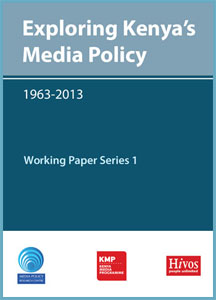In 2014, I had the pleasure of contributing to a fascinating production titled Exploring Kenya’s Media Policy Landscape: 1963-2013. Commissioned by the Media Policy Research Centre, I was tasked with exploring the impact of social media on journalism in Kenya. I assessed some conceptual frameworks on social media, social media’s effects on communication – the rise of citizen journalism, examples of social media users challenging traditional media (#someonetell…), as well as a critique of online citizen journalism. I also investigated social media adoption trends by mainstream (traditional) media, benchmarking the local against international media. The challenges and opportunities of social media for mainstream media, as well as social media’s implications for media policy (e.g. whether bloggers are journalists) round up the chapter contribution.
The working papers collection was officially launched on 27 February 2015.
Below is the executive summary of the working paper, and a link to the publication download (page 66- 90). I welcome feedback and additional thoughts on other factors to consider. (It was also very interesting and saddening to note the dearth of analysis on this subject matter during my literature review).
The [social media and journalism] chapter explores the impact of social media on journalism, with examples and analysis anchored in the Kenyan context. It begins with an overview of social media, the tools and practices shaping it, and dives deeper into the social media landscape in Kenya. Social media structure and adoption is increasingly challenging ‘traditional’ channels and agents of information dissemination in the country. Journalists and mainstream media are no longer the sole or primary source of breaking news. Citizens are now more connected with each other through platforms that enable conversation, co-creation and in some instances organizing towards collective action. Through social media, and citizen journalism, there has been an amplification of voices, groups and communities that would not otherwise attract mainstream media attention. Several examples of how social media users have challenged both local and international traditional media’s reportage on national issues are highlighted. Social media use, however, is hinged on opting in, which is a factor of access and affordability of Internet and (mobile) devices. The limitations notwithstanding, social media continues to be adopted by Kenyan media, informing various practices such as setting up of blog sections on the media’s online portals, use of social media to stir conversation around news content, introduction of social media editors, and social media policy guidelines for journalists. The role of journalism remains significant, to sift through vast volumes of data and information generated, and make sense of it through application of journalistic skills. Though social media hasn’t yet completely disrupted journalism and traditional media in Kenya, its significance and ubiquity continues to rise and challenge the latter’s practices. How social media impact straditional media’s monetization streams as well as media policies is also discussed. The chapter concludes with the recommendation that more research and studies on social media in Kenya should be conducted in Kenya, to better inform policy practices. Journalism practitioners, trainers, researchers and policymakers should continue to assess and appreciate social media’s value in Kenya towards improving the media industry and creating a more democratic society.

